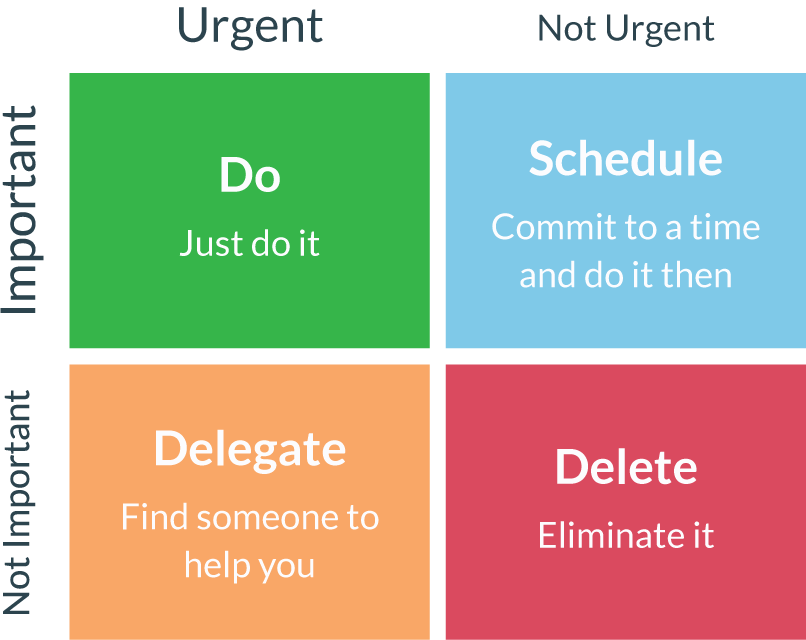
Going beyond the Eisenhower Matrix
In one of my previous posts, I’ve mentioned the importance of getting better at managing your energy. In today’s post, I’d like to explore one of the tools that could support you throughout the process.
What is the Eisenhower Matrix?
The Eisenhower Matrix is a tool for prioritizing tasks. The name comes from the 34th President of the United States, Dwight Eisenhower. One of the quotes attributed to him explains the core of the Principle:
“What is important is seldom urgent and what is urgent is seldom important.”
This rule plus Eisenhower’s approach to making difficult decisions, were the motivation behind creating a simple matrix that can be used by almost anyone in any situation.
How to use it?

The Matrix is divided into quadrants which makes it very easy to use. You can just write down all your tasks and then assign them to each of these sections according to how important/urgent they are.
Once you’ve done it, deciding what to do with them will be less difficult. Here’s a template that you can use for it.
1. Important and urgent
These are the tasks that you need to complete first and immediately. Make sure they’re a balanced mix between your ‘drainers’ and ‘energizers’.
2. Important but not urgent
Here’s where you’d set some time to tackle the tasks later. You may feel tempted to just tick them off your list and say ‘I’ll deal with it when I’ve got more time’, but don’t do it. The right way to do it is by opening your calendar and yes, actually scheduling exactly where you’ll make it happen.
3. Not important but urgent
The third quadrant holds the tasks that can be easily handed over to other people on your team. And even if the preparation would take some time, it’s worth doing that. Not only for other team members who could gain new skills or get better at things they’re interested in but also for yourself. Delegating some of your responsibilities will free up your time so you can focus on things that are important (first and second quadrant).
4. Not important, not urgent
Congratulations, you’ve just done yourself a massive favor! In this quadrant, you’ve listed all the tasks that you can delete without ever looking back. Do it now, don’t regret later.
How to distinguish between urgent vs. important?
Distinguishing between your urgent and important tasks is tricky. It’s also the key to getting time management right.
Almost all of us instinctively feel that urgent things are also the most important ones. That’s why it’s so easy to trick us into responding to each and every notification, email, and request as soon as they come in. We feel that tackling them as soon as they appear in front of our eyes will make us more productive.
It won’t. On the contrary, dealing with urgent things not really considering if they’re important or not will hinder your effectiveness. Next time, you’re faced with a situation like that, try asking yourself: ‘Is it important? Is this really the thing I should be working on right now?’. If the answer to any of these questions is ‘No’, then you know what to do. Don’t just head first as soon as you see something immediate/demanding. Stop and think instead.
Going beyond the Eisenhower Matrix
- If you’d want to take just one thing from this article, it should be: eliminate distractions. Just removing things that stop you from doing what’s most important is a powerful tool in itself.
- Start your task management journey by picking just one big thing you’ll do each day. Your energy is not a ceaseless resource, and no, you can’t handle it all at once. Learn how to better manage your energy, and you’ll gradually be able to increase the number of important tasks you can pull off in a day.
- Procrastination is not a matter of laziness, boredom, or lack of time management skills. This recent study shows that you’re not putting things off because you’re careless and apathetic. You do it because you can’t deal with the negative emotions that are attached to these things/tasks. Identify these and tackle the root cause, and you’ll become more productive.
- Apply the matrix not only to your professional but also your personal life. It would allow you to plan and schedule different activities so they wouldn’t overlap.
Your turn
What are your experiences using the Eisenhower Matrix? What other tools have helped you in avoiding burnout? Feel free to share your stories on Reddit or in our Community.